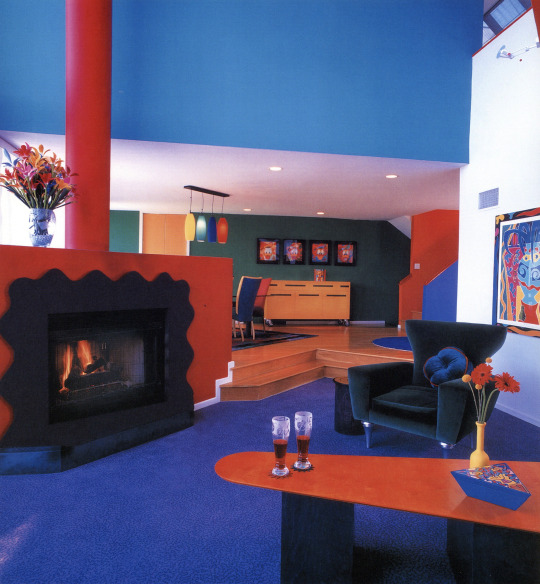#wacky pomo
Text
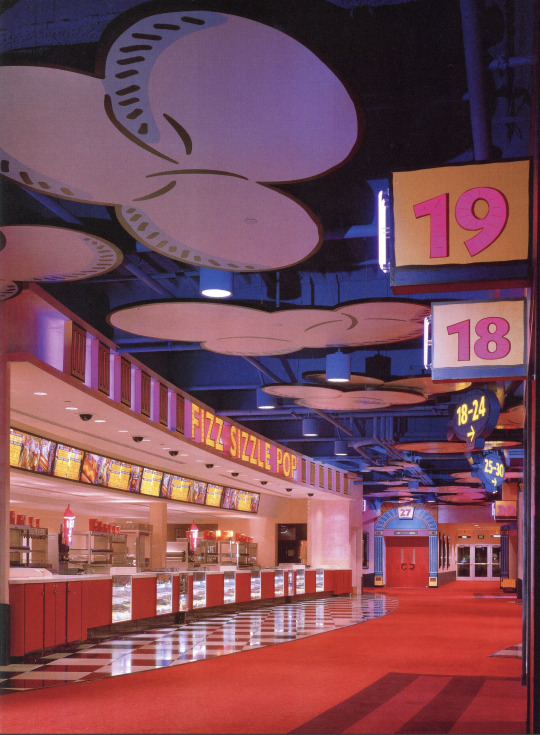

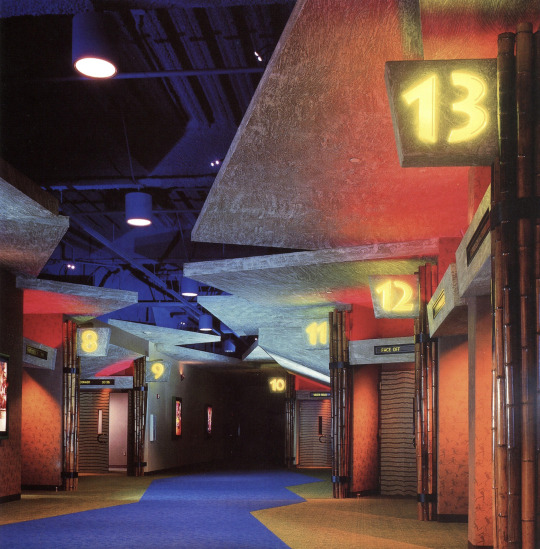



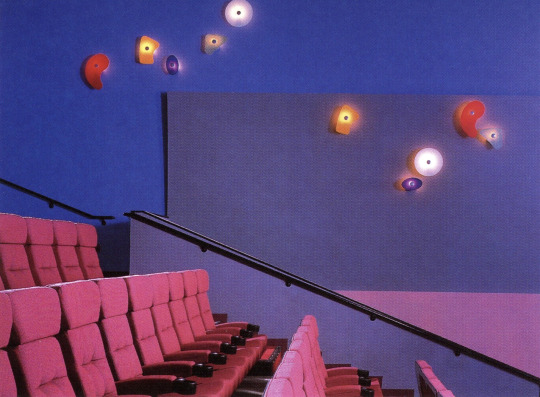

AMC Studio 30 Theatre - Houston, TX (1997)
"What the design attempts to do in the 110,000 sq. ft. space is simulate a movie studio backlot and the soundstage where guests become part of the action, and the experience "rekindles the magic and memory of movie going."
Elements from sound stages and studio road cases make up the central lobby space along with a guest service desk. Images of Hollywood's glamorous stars of the past add enchantment to the balcony walls. The space is divided into three themed areas that "transport guests into fantastic worlds of Animation, Action/Adventure and Cyberspace." The food concession stands within each area carries through the theme; "Fizz, Sizzle, Pop"; Wildebeest Feast"; and "Quantum Bits." The 30 auditoria are located off the soundstage lobby and within the various themed areas.
The architecture seems to come alive in the Animation area. The space is designed to resemble an animation cel: "flat, two-dimensional, cartoon-like graphics are outlined with black lines, filled with color and applied on an exaggerated scale." The Fizz, Sizzle, Pop concession's identity and blimp directional signs seem to float in a blue sky with flat, cut-out clouds. The setting for Action/ Adventure recalls a rainforest with heavy hanging leaves, bamboo and rock "carved" directional signs. The custom wall covering features petroglyphs of cave people carrying popcorn, megaphones and movie cameras. The fiber optic eyes peering from behind the leaves in the Wildebeest Feast stand change color. They also appear above rock outcroppings down the corridor. Patrons are invited to explore an abstract, futuristic world in Cyberspace where the floor and ceiling are the same color and brushed aluminum columns rise partway to the ceiling. To create the illusion of "endless space." custom light fixtures project beams of light along the walls and backlit graphic images have neon edges. Various colored lights and a high-tech fluorescent green/orange acrylic sign help to define the Quantum Bits concession area in Cyberspace."
Designed by Kiku Obata & Co.
Scanned from the book, Entertainment Destinations by Martin Pegler (2000)
#design#90s#interior design#interiors#architecture#1990s#colorful#movie theater#houston#texas#themed spaces#multiplex#pop art#y2k#factory pomo#rainforest#cyber#cartoon#wacky pomo
716 notes
·
View notes
Text
FRANKENPHOTOS TIME









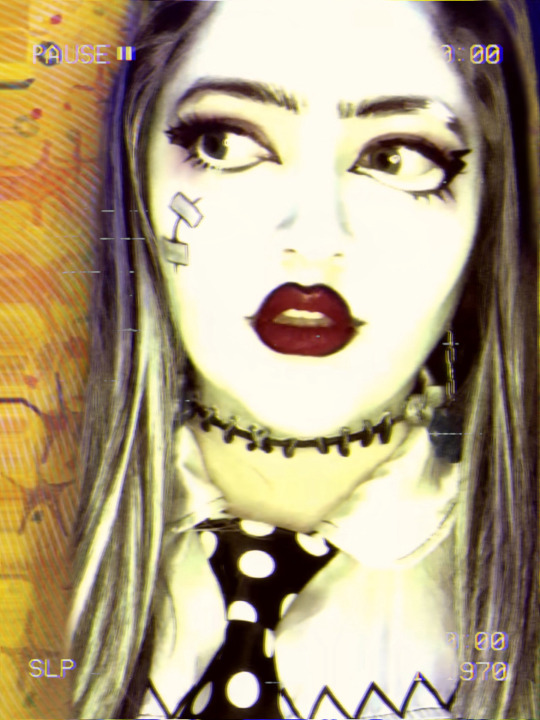
#monster high#frankie stein#monster high costume#monster high cosplay#mh cosplay#cosplay#frankie stein cosplay#frankie stein costume#monster high edit#mh edit#mh frankie stein#frankie mh#mh frankie#frankie monster high#mh#monster high frankie#costume#makeup#edit#photo dump#zimulacrum#they them#frankie stein monster high#wacky pomo#y2k#vintage horror
41 notes
·
View notes
Text
genuinely hope that art forms like wacky/wacko pomo and memphis jr. get some form of recognition like frutiger aero is getting nowadays ..
#idk w/ how a lot of ppl (including myself) often talk about how much they miss when mainstream designs weren't afraid to be eccentric#and colorful i thought i would see a lot more people posting about them under these names specifcally .
4 notes
·
View notes
Text
genloss wacky pomo art is the best thing ever
2 notes
·
View notes
Text
i love you postmodern architecture and interior design and graphic design i love you factory pomo i love you wacky pomo you were so beautiful and whimsical i miss you every single day i would kill to bring you back
16 notes
·
View notes
Text


~~~~~~~~~~~~~~~~~~~~~~~~~~~~~~~~~~~~~~~~~~~~
Wackypomic
a gender connected to or influenced by the 1980s - early 2000s micro aesthetic Wacky Pomo/Wacky Post Modern. It most commonly included cartoonification, bright colors, explosion and ooze motifs, mad scientist/hypnosis swirls, and was mostly used as an aesthetic for marketing to kids.
Video Reference
~~~~~~~~~~~~~~~~~~~~~~~~~~~~~~~~~~~~~~~~~~~~
14 notes
·
View notes
Text
The name of the game on so many islands seems to be ENDLESS SYMMETRY!!! which I get because it does make it easier.
Unfortunately I'm trying to put a façade around my house to honor the weirdness and asymmetry of Pee-Wee's Playhouse, BJ's Roadhouse (from the animated Beetlejuice), Gonzo's imagination from Muppet Babies (the 1980s version), and IRL postmodern architecture, because the new theme is Weird!!!!*
So trying to search up inspiration for my wacky pomo in-game house is proving Difficult because so many façades and fake buildings are intensely symmetrical :c And I need asymmetry-with-balance and funky objects. Even kidcore islands seem to embrace a lot of symmetry.
The pain of genius right here.
*yeah, the tropical island theme crashed and burned; don't ask...
1 note
·
View note
Text
Shutterbug mag

SHUTTERBUG MAG MOVIE
SHUTTERBUG MAG DRIVER
these contacts are not there on cameras prior to the K10D. Well if the statment is true they use motors in the lens which are driven by contacts on the body. To bring out new lenses that wont function on older cameras has not been Pentax's way (well at least not in the past). it has been reported that a Pentax person has said that they will have both the USM and the inbody focusing systems in current AF cameras. The putatively sophisticated mythos of the narrative and various plot devices aside (Alex’s journey is clearly intended to be optimistically Orphic, with his camera hanging portentously around his neck like an albatross pendant), Shutterbug is little more than a childishly incoherent, urban fairy tale.Emphasis is mine. The script’s vacuity crescendos in the oneiric third act, where Alex’s ongoing hallucinations of curly-haired females intensify with both rear-projected and chroma-keyed Photoshop landscapes and unconvincingly mobilized toy station wagons, all of which provides the film with a unique look that’s strikingly both digital and handmade but also ultimately hollow beneath the surface.
SHUTTERBUG MAG DRIVER
The stale, didactic dialog is rendered all the more contrived by rigid edits that punctuate nearly every sentence in some scenes basic human gestures, such as hands gripping telephoto lens or clasping quivering wrists, are captured with nervously punched-in, obscene close-ups that fracture whatever natural rhythm may have been achieved and Alex’s various guides through the NYC underworld become unnecessarily antagonistic without warning or provocation (one particularly confusing exchange with a taxi driver ends brutally after Alex simply requests to be taken to an address with no questions asked). But Papas also shares his protagonist’s lack of depth and mind-numbingly flashy self-consciousness, and as a result his film is a lengthy exercise in professionally-executed vapidity. Papas is a gifted photographer, or has at least hired one: The precision of his color-coded yuppy palace, a loft apartment with piercing white window glare and charred yellow tank tops, is scathingly alluring, and a cunning environment against which the flat, crisp resolution of the movie’s digital video can expose the haughtiness of the film’s characters. Papas additionally peppers his pomo-urban microcosm with ghostly Gaussian smears that patrol the borders of Alex’s consciousness and compel him to search for meaning outside the 8×10 glossy-a subplot included mostly to prop the interpretative door just ajar enough for dream logic to squeeze through as an eye roll-inducing explanation for the benignly wacky antics Papas thinks up. After embarking on a hellishly ambulatory night trek through Manhattan’s underbelly, Alex encounters tetchy skaters, homeless sages, condescending cabbies, and other misappropriated Joseph Campbell tropes that evince a tenuous grasp of the mythic New York let alone the genuine one.
SHUTTERBUG MAG MOVIE
The movie follows a celebrated but archetypically cocky photographer named Alex (Nando Del Castillo), who attempts to win arguments with his girlfriend by flinging cheesy black and whites of local architecture and insisting for no apparent reason that his prints are at the core of his tortured identity. One-third lysergic plutonian tour, one-third attempted digital-art mindfuck, and one-third pointlessly phantasmagoric twist thriller, Minos Papas’s Shutterbug stylistically suggests the planate obtuseness of an aesthetically stunted man’s David Lynch and the emotive stiffness of the real M.

0 notes
Text
Credit @EvanCollins90 on Twitter
Nickelodeon 'Nicktoons' animation studio in Burbank, CA (late 1990s)








49 notes
·
View notes
Photo
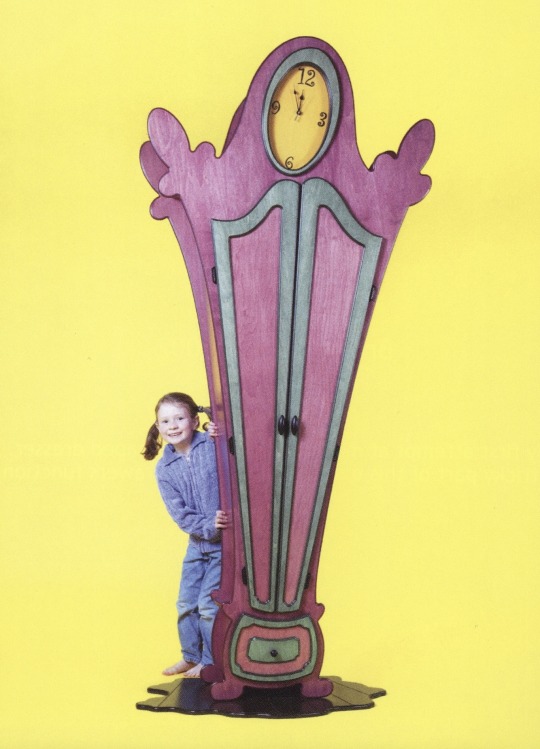






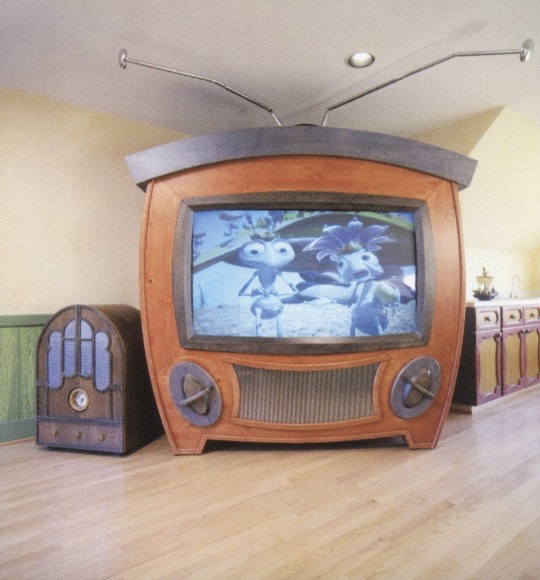

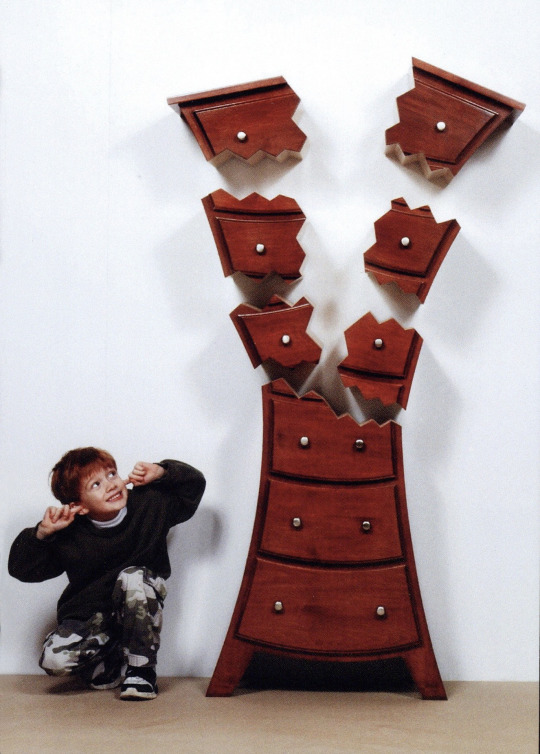
Found a book of custom furniture by Judson Beaumont (1992-2005)
Falls mainly into the whimsical Wacky PoMo style
Scanned from What’s Next? by Judson Beaumont (2007)
8K notes
·
View notes
Note
hello! so i made this carrd on pomosexuality pomosexuality-carrd-co but my account is really small so it couldn't reach many people. if you don't mind, can you please check it out and tweet about it if it's not a problem..?
Hi! I’ve been sitting on answering this message because i don’t want my response to come off as rude. Your carrd doesn’t mention the book about pomosexuality written by the people who coined the term, which is pretty important if you’re carrd is meant to be educational. I hope you don’t mind me giving you some quotes from the book that you can add to the carrd.
The book is PoMoSexuals: Challenging Assumptions About Gender and Sexuality by Carol Queen and Lawrence Schimel, published in 1997. The term pomosexual is briefly explained, “PoMo: short for PostModern: in the arts, a movement following after and in direct reaction to Modernism; culturally, an outlook that acknowledges diverse and complex points of view. PoMoSexual: the queer erotic reality beyond the boundaries of gender, separatism, and essentialist notions of sexual orientation.”
And here are some more explanations and insight to what they intended pomosexual to mean, which is not as simple as being a label for someone who doesn’t want, like, or fit labels.
“We don't propose that ‘pomosexual’ replace LGBT&F. We're not interested in adding another new name to the slew we already have, though we acknowledge the usefulness of having one name by which all LGBT&Fs might be called. ‘Pomosexual’ references homosexuality even as it describes the community's outsiders, the queer queers who can't seem to stay put within a nice simple identity. We coin the term to situate this book and its essays within and in relation to the LGBT&F community. It is in every way an artifact of, and in many ways a backlash toward, this community—or rather, to certain assumptions widely held within and/or about it, essentialist assumptions about what it means to be queer. We react against these assumptions in the same way that in the art world Postmodernism was a reaction against Modernism.”
-
“Postmodernism looks for art and meaning sourced in the mundane, in wacky or arcane juxtapositions, in low as well as high culture. In this it bears some relationship to camp, queerdom's own ironic social theory, which developed to let us criticize (particularly heterocentrist) relations of power. Postmodern thought invites us to get used to the Zen notion of ‘multiple subjectivities’—the idea that there is no solid, objective reality, that each of us experiences our reality subjectively, affected (or influenced) by our unique circumstances. This mode of thought encourages overlapping and sometimes contradictory realities, a life of investigation and questioning as opposed to essentialism's quest for the One Truth, the innate quality, indubitable facts on a silver platter, the answer to everything.
What happens to identities based on essentialist thinking when we begin to challenge fixed notions of gender identity, binary thinking, monosexuality? When we want names that acknowledge and help shape how various we are? When gender dysphoria becomes first a sex toy or a way of life, then an inspiration to think about the mutability of everything we have been taught to consider fixed? When we insist on identities that embrace our diversities and refuse to gloss them over?
The problem with any ascribed and adopted identity is not what it includes, but what it leaves out. Indeed, there are so very many ways to live in the world, countless sources of affinity, that our sexualities and gender/identities only go so far in describing, constructing, and supporting us. To combat the ‘cosmic aloneness’ that is integral to being human, that aching awareness that no one can truly share your experiences (paralleling the koan that one can never stand in the same river twice; the water that made up the river at that moment is forever gone once the moment has passed), we form communities and subcommunities grouped around shared history and interests, links of family and ethnicity, religion and sexuality, anything which makes us feel more connected to others and less alone.”
-
“Twenty year ago, identity seemed self-evident. There were men, and there were women. Some were gay and some were straight. Bisexuals and transsexuals were suspect because their position on the sexual spectrum implied transition, disloyalty, or kinky hedonism; because their position on the gender spectrum implied permeability of a membrane we were all raised to see as solid; and because, when all was said and done, even homosexuals and women mostly believed that biology was destiny. The dissent had only to do with what that destiny might be.
But bisexual never shut up and went away. Omnisexuals and pansexuals began to dot the landscape. Women who had been born with penises sought to attend the Michigan Womyn's Music Festival and, slowly, other dykes began to agree they ought to be there. Men born without cocks and balls fought doctors for permission to get gender reassignment surgery even though they intended to begin new lives as gay men. The practices and language of S/M began to move out of the dungeons and into the discourse. Lesbian butch/femme reasserted the erotics of gender in what was supposed to be an androgynous future, keynoted by what de Beauvoir called ‘the miracle of the mirror.’ Phrases like ‘butch bottom’ began to dot the personals. Anyone with eyes and a brain could see categories breaking down, assumptions rupturing, clear-cut identities going the way of the Berlin Wall.
Hence the ‘pomosexual,’ who, like the queer s/he closely resembles, may not be tied to a single sexual identity, may not be content to reside within a category measurable by social scientists or acknowledged by either rainbow-festooned gays or by Ward and June Cleaver.
Pomosexuality lives in the spaces in which all other nonbinary forms of sexual and gender identity reside—a boundary-free zone in which fences are crossed for the fun of it, or simply because some of us can't be fenced in. It challenges either/or categorizations in favor of largely unmapped possibility and the intense charge that comes with transgression. It acknowledges the pleasure of that transgression, as well as the need to transgress limits that do not make room for all of us.”
-
“We do hope this book makes people question and rethink their own identities—not necessarily with the intent of changing them, but of better understanding other identities. We hope it pushes people who live more or less nonproblematic lesbian and gay lives to look more clearly and compassionately at their neighbors for whom things are not as simple. We hope this book makes some people feel less alone.
We learn and live through our stories; when something wonderful happens in our lives or we arrive at some profound revelation, our impulse is not to hoard it but to share the story with our friends and families, with our communities, so they can recognize themselves—and know us better—in the telling. This book shares some stories of investigations, of assumptions overturned, within our communities and our lives. We hope these stories inspire and entertain, that they make you think, that they raise questions.
We pomosexuals are the queer's queers, the ones who will no stay in the boxes marked ‘gay’ and ‘lesbian’ without causing a fuss—just as we all burst out of the boxes the straight world tried to grow us in. At bottom, we want our communities (whatever they are or are not called) to embrace and support more of us.”
I know those quotes are pretty long, but i think it’s important to share as much information about pomosexuality as you can if you want people to educated on it. And since this comes from the people who coined the term, it’s much better than any other sources.
I really hope you don’t take offense to this. I really don’t mean any disrespect, I just want to help people be educated on queerness.
#asks#anonymous#pomosexual#reference#also i noticed that your two sources were copied and pasted from my carrd - even the bits that were my words#and like it's not a big deal but it an acknowledgement of it would be nice especially since you were asking me to promote your carrd#which brings me to this - i'm not gonna tweet about it because my acc is pan focused#but this message alone will reach more people than a tweet would anyways because i have more followers on here#again none of this is to be mean or disrespectful or anything like that#long post
54 notes
·
View notes
Photo

PoMo coffee table and desk, Memphis style fireplace screen, sponge painted walls, white zigzag molding, wacky hot pink throw pillows, triangle mirror. From New Guide to Decorating, Mary Gilliatt, 1992
98 notes
·
View notes
Photo
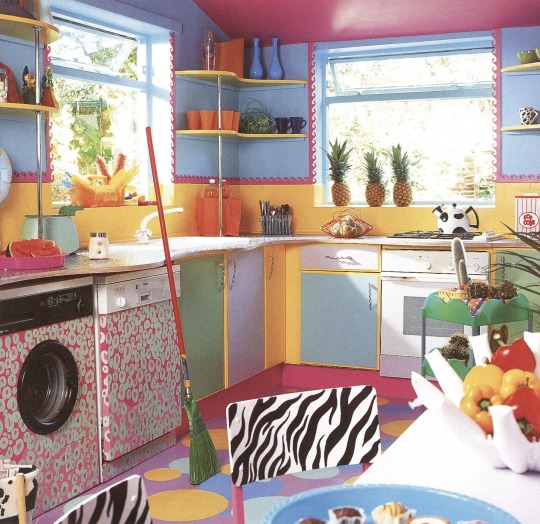


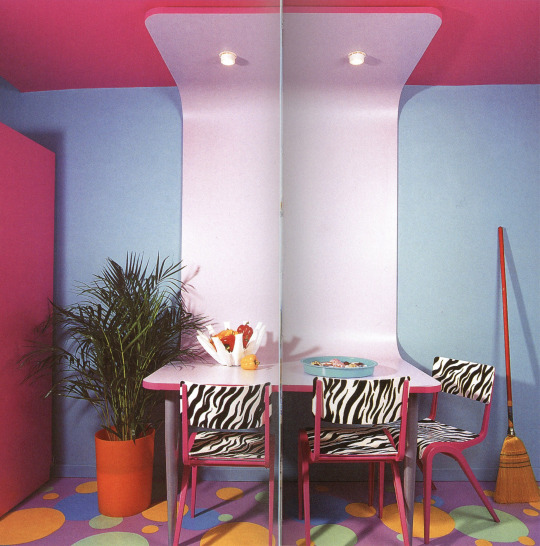
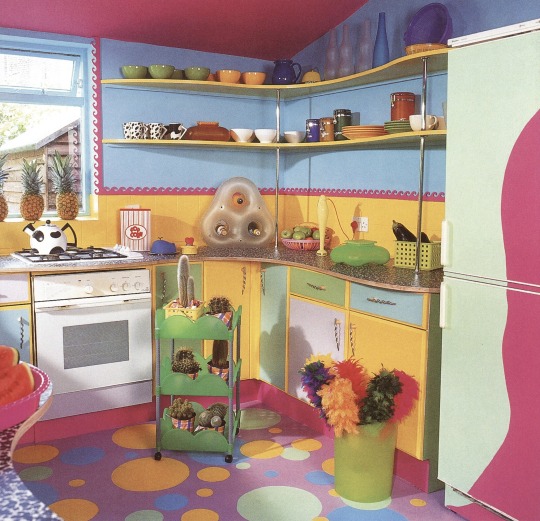
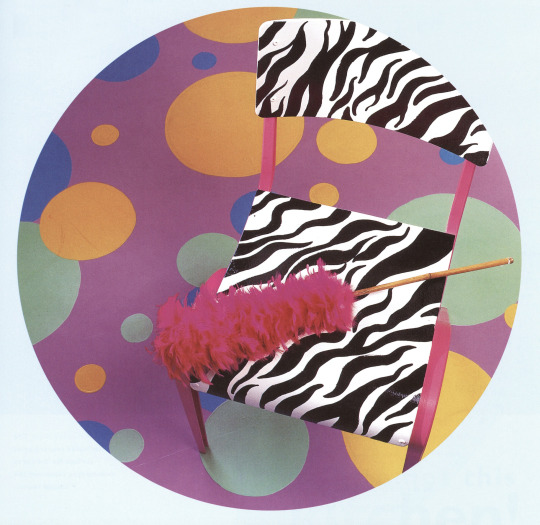


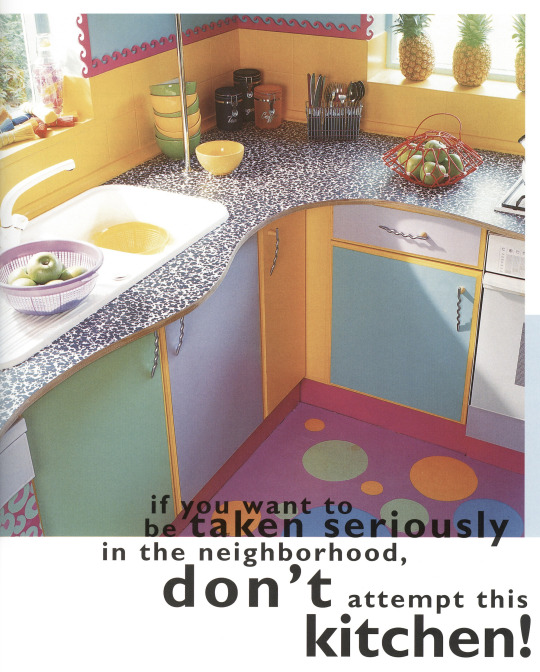
'Kitsch Kitchen' designed by British TV personality & designer, Anne McKevitt
Not sure what I'd call the style, it's like a mix of 1950s-60s Googie kitsch, some Y2K pieces by Inflate & Stefano Giovannoni, and the 'Wacky PoMo' aesthetic. Memphis-esque patterns (reminds me of Sottsass's 'Bacterio'). I think Memphis took some inspiration from the kitschy 1950s formica/Googie stuff, so kinda ties together here.
Scanned from 'House Sensation' (1998)
5K notes
·
View notes
